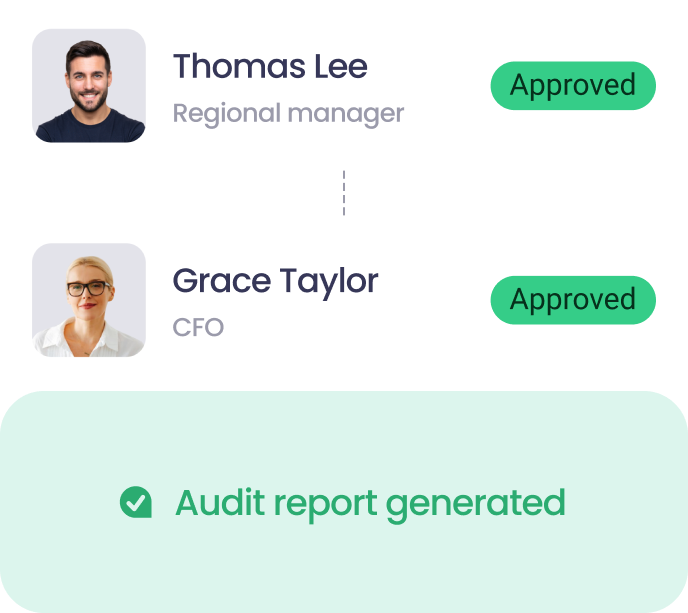
Accounts receivable KPIs: What to measure and why it matters

Reliable cash flow starts with disciplined receivables management. Knowing who owes what, and when funds are due, lets finance plan payroll, supplier commitments, tax deadlines, and investment timing.
This is where accounts receivable (AR) KPIs make a difference. They reveal how well your business is tracking its collections and where there is room for improvement, giving you a better understanding of your cashflow. This turns collections from a guessing game into a measurable and actionable process.
Tracking AR KPIs is about more than reporting. These metrics can influence liquidity, growth, credit risk, and financial planning.
In this article, we’ll break down 11 important accounts receivable KPIs to track and how to measure them. We’ll also cover industry benchmarks and how automation supports the entire process.
• The most important KPIs for cash flow are DSO, CEI, and the percentage of receivables over 90 days.
• A healthy DSO is under 45 days for most businesses and under 30 days for SMBs
• Useful benchmarks: CEI 80–90%+, AR >90 days under 15–20%, bad debt ratio under 1–2%, AR turnover 6–12 times per year.
• Invoices unpaid for over 90 days are much less likely to be collected and increase business risk.
Why tracking accounts receivable KPIs is critical
Accounts receivable KPIs are strategic insights into the health of your business. When payments are late or mistakes happen, cash flow can suffer, making it harder to keep your business running smoothly. This might mean delaying payments to your own suppliers or even relying on lines of credit to bridge the gap.
Measuring AR KPIs gives you:
-
Visibility: Spot issues before they become bigger problems. For some smaller businesses, invoices sitting in 30-60 days can be a problem, while larger companies may focus on those sitting in 90+ days.
-
Control: Know where delays or disputes sit in your process, so you can resolve them quickly.
-
Confidence: Build trust with investors, lenders and internal teams through accurate and transparent reporting. This reduces the risk of surprises later on, such as cash flow shortfalls.
How to choose the right accounts receivable KPIs for your business
Every business should establish its own unique set of accounts receivable KPIs. No two businesses are the same, so the metrics you track will depend on your industry, customer base and goals.
Here are three steps to follow to determine yours:
-
Match KPIs to your challenges: Focus on metrics like Days Sales Outstanding (DSO) if late payments are your biggest issue. . If errors or disputes slow you down, track invoice accuracy and dispute rates instead.
-
Balance speed and quality: Efficiency KPIs (like DSO or AR turnover) show how quickly you collect payments. Quality KPIs (like accuracy rate or error rate) show how clean your process is. A balance of both is best.
-
Pick KPIs you can act on: Tracking numbers alone doesn’t help. Choose KPIs you can actually improve with better processes or automation. For example:
-
Lowering DSO with automated payment reminders
-
Increasing invoice accuracy with approval workflows
-
Improving forecast accuracy with real-time data
-
Effective accounts receivable KPIs should reflect your business model, highlight risks early on, and bring real improvements.
Top 11 accounts receivable KPIs with formulas & benchmarks
Here are 11 essential KPIs to track, including what they measure and how to calculate them:
Days Sales Outstanding (DSO)
DSO shows how many days it takes, on average, to collect payment from customers.
- Formula: (Accounts Receivable ÷ Total Credit Sales) × Number of Days
- Why it matters: A high DSO means a payment is tied up for longer, which can tighten cash flow.
- How to improve: Speed up invoicing and use automated reminders to encourage faster payments.
Average Days Delinquent (ADD)
ADD tracks how many days customers pay beyond agreed terms.
-
- Formula: DSO − Best Possible DSO
- Why it matters: Late payments hurt cash flow and increase the risk of bad debt.
- How to improve: Set clear payment terms and follow up quickly when invoices become overdue.
Collection Effectiveness Index (CEI)
CEI measures how effective your team is at collecting receivables in a given period.
- Formula: (Beginning AR + Credit Sales − Ending AR − Write-offs) ÷ (Beginning AR + Credit Sales − Ending AR) × 100
- Why it matters: A high CEO suggests collections are strong, while a low one signals gaps in your process.
- How to improve: Prioritise overdue accounts and use AR automation to keep collection efforts consistent.
Accounts Receivable Turnover Ratio (ART)
ART shows how many times receivables are collected during a specific period.
- Formula: Net Credit Sales ÷ Average AR
- Why it matters: A higher turnover ratio means your business collects payments faster and reduces risk.
- How to improve: Tighten credit terms and follow up on overdue accounts more actively.
Bad Debt Ratio / Write-offs
This ratio tracks the percentage of receivables that won’t be collected.
- Formula: Bad Debt ÷ Total Credit Sales × 100
- Why it matters: Bad debt reduces profitability and can signal weak credit controls.
- How to improve: Screen customers and monitor payment behaviour regularly.
Invoice Accuracy Rate (Disputes)
Invoice accuracy rate measures how many invoices are issued correctly without disputes.
- Formula: (Total Invoices - Disputed Invoices) ÷ Total Invoices × 100
- Why it matters: Inaccurate invoices cause delays and harm customer relationships.
- How to improve: Use approval workflows to check invoices before sending them.
Percentage of AR Over 90 Days (Aging)
This is a percentage that shows what portion of receivables are overdue by more than 90 days.
- Formula: Accounts receivable over 90 days ÷ Total accounts receivable × 100
- Why it matters: The longer invoices stay unpaid, the less likely they are to ever be collected. Late payments also impact cash flow and future-proofing.
- How to improve: Act early on overdue accounts and adjust credit limits for risky customers.
Expected Cash Collections / Forecast Accuracy
This figure compares predicted collections against what actually comes in.
- Formula: Actual cash collected ÷ Forecasted cash collections × 100
- Why it matters: Accurate forecasts give you better control over cash flow and planning.
- How to improve: Use real-time data from your accounting system to update forecasts.
Cost of Collections
Shows the cost of collecting receivables compared to the total collected.
- Formula: Total Collection Costs ÷ Total Collected AR × 100
- Why it matters: High collection costs eat into margins and show inefficiency.
- How to improve: Automate routine tasks and reduce manual follow-ups.
Payment Error Rate / Misapplied Payments
The payment error rate is tracked as a percentage and shows how often payments are posted to the wrong account or invoice.
- Formula: Number of misapplied payments ÷ Total payments received × 100
- Why it matters: Errors create disputes, delay reconciliations and frustrate customers.
- How to improve: Automate payment matching and reconciliation to reduce mistakes.
Cash Conversion Cycle (CCC)
CCC measures how long it takes to convert investments in inventory and receivables into cash.
- Formula: DSO + Days Inventory Outstanding - Days Payables Outstanding
- Why it matters: A shorter cycle means your business gets cash back faster to reinvest.
- How to improve: Speed up collections and optimise how you manage inventory and payables.
Benchmarking AR KPIs: what good looks like
There’s no one-size-fits-all benchmark. A DSO that’s healthy for a SaaS company might be a red flag for SMBs with longer payment cycles.
External benchmarks show how you compare to peers, but the real value comes when you use them to shape your own internal benchmarks.
Here are some industry benchmarks to help you get started:
Common mistakes businesses make when tracking AR KPIs
Automation improves how you track and manage AR KPIs, but make sure to watch out for these common mistakes:
- Tracking too many metrics without doing anything about them. Keep things simple and actionable.
- Focusing only on DSO. This is important, but ignoring disputes, errors, or aging receivables leaves blind spots.
- Treating KPIs as a reporting exercise. KPIs should drive decisions and improvements.
How to improve AR KPIs
Tracking KPIs highlights where problems lie, but it doesn’t fix them. That’s where automation comes in. Here's what accounts receivable software improves:
ApprovalMax helps to bring all of this together by streamlining your accounts receivable processes. With automated approval workflows, clear audit trails, and seamless integrations with leading accounting platforms, you can track payments more efficiently, reduce errors and strengthen your cash flow management.
How can ApprovalMax help
Accounts receivable KPIs are key when it comes to understanding your cash flow health. They offer visibility, reduce risk, and strengthen financial planning – but only when action is taken to improve them.
ApprovalMax gives finance teams the tools to monitor and improve their KPIs.. The result? Payments come in faster, mistakes are reduced, and cash flow is steady.
Learn how accounts receivable software can support your KPIs, giving you stronger financial controls and clearer visibility into accounts receivable.FAQs
Which AR KPIs matter most for cash flow?
DSO, CEI, and percentage of AR over 90 days are the most direct indicators. Refer to the KPI section above for a more detailed breakdown.
What is a good DSO benchmark?
Under 45 days is typically considered a good DSO for most businesses, while under 30 days is ideal.
How can automation improve accounts receivable KPIs?
Extend the benefits of stronger financial controls and automated workflows to how you quote, invoice, and get paid.
What’s the difference between AR KPIs for SMBs vs enterprises?
For SMBs, AR KPIs are usually about survival. They should make sure cash comes in quickly enough to cover expenses and keep the business running.
Enterprises deal with larger volumes of invoices, so AR KPIs need to balance efficiency (collecting cash quickly) with accuracy and control.
What is the difference between AR KPIs and AR metrics?
Metrics are any data points you can track, while KPIs refer to specific metrics tied to performance goals – such as reducing DSO or keeping bad debt below 2%.
Ready to Simplify Your Approval Process?
Justin Campbell, an experienced accountant with a decade at Xero, blends his deep understanding of finance and technology to simplify processes. He uses his expertise to help businesses work smarter, bringing precision and innovation to every initiative.
Set up a system of checks and balances for your financial operations.
Multi-step, multi-role approval workflows for financial documents.

Auto-generated audit reports for each approved item.

Get alerts for fraudulent activity and protect against it happening.
Leave printing in the past with fully digitised workflows.





.png?width=1248&height=936&name=Ar_automation_blog_4%20(1).png)
